Nina Munteanu's Blog, page 14
April 11, 2012
Importance of Setting in a Novel
 Create memorable settings using time, place and circumstance.
Create memorable settings using time, place and circumstance.Setting grounds your writing in the reality of place and depicts the theme of your story through powerful metaphor. Without setting, characters are simply there, in a vacuum, with no reason to act and most importantly, no reason to care. Without a place there is no story. Setting serves multipurpose roles in story. It helps with plot, determines and describes character and gives metaphoric links to theme. Setting, like the force in Star Wars, provides a landscape that binds everything into context and meaning.
Place Your Story
According to acclaimed novelist Richard Russo, if you're not writing stories that occur in a specific place, you're missing the opportunity to add depth and character to your writing. We are creatures of our environment, adds Robert Louis Stevenson. Our outlook on life is colored by the setting in which we find ourselves. Editors have told me that they have little faith in the vision of writers who don't clearly depict the world their characters inhabit. Imagine Thomas Hardy's characters without Egdon Heath or Scarlet O'Hara without her beloved Tara or Dorothy without the Land of Oz.
Setting includes time, place and circumstance. These three form a kind of critical mass that creates the particular setting best suited to your story. If you change any of these it will affect the quality of the others.
Setting as Character
Settings can not only have character; they can be a character in their own right. A novelist, when portraying several characters, may often find herself painting a portrait of "place". This is setting being "character". The setting functions as a catalyst, and molds the more traditional characters that animate a story. The central character is often really the place, which is often linked to the protagonist. In Lord of the Rings, for instance, Frodo is very much an extension of his beloved Shire. Setting, then, comes to mean so much more. Setting ultimately portrays what lies at the heart of the story.
Setting as Metaphor
When you choose your setting, remember that its primary metaphoric role is to help depict theme. This is because place is destiny. Russo tells us that place is crucial to human destiny and the formation of human personality. "The more specific and individual things become, the more universal they feel," says Russo. This is not an oxymoron, but an example of the principle of a truism, which comes to us in the form of paradox (like all good truisms).
Detail provides the color and texture of your story and helps it resonate with a sense of place. This does not necessarily translate into lots of exposition; but it does require creative choice of words. So, instead of "John took a drag from his cigarette as he drove his sports car along a winding road in the country" (twenty words) try something like "Vinnie sucked on a Camel as his red Corvette careered the hair-pinned curves of Hell's Gate" (seventeen words).
Setting & Emotion
The setting may amplify a character's emotions or contradict them, depending on the circumstance of the character, her mood, disposition, tendencies, and observational skills. And the kind of story you're telling. Either way, setting provides an "emotional landscape" upon which a character's own temperament may play counterpoint or may resonate in a wonderful symphony. The writer should think of the less obvious, of contrast, and how you can increase tension and emphasize the character's situation.
Setting as Weather
Weather conveys the mood and tone of both story and character. Weather is not just part of the scenery. To a writer, weather is a device used in plot and theme. A good example is Michael Ondaatje's The English Patient and how he used the desert setting and the hot winds to evoke mood, character, tension, theme and ultimately story:
"The desert could not be claimed or owned—it was a piece of cloth carried by winds, never held down by stones, and given a hundred shifting names long before Canterbury existed, long before battles and treaties quilted Europe and the East"
In summary, here are some suggestions that will help you create vivid, memorable and meaningful settings:
• Don't "tack" setting in; make it an integral part of the story; give it purpose
• Describe selectively and with purpose—through integration in "scene" rather than exposition
• Be specific (e.g., soft pink rose, not flower; beat up Chevy, not car; old clapboard cottage, not house)
• Use similes, metaphors, and personification to breathe life into setting
• Use the senses like sight, sound, smell, taste, feel
• Don't tell, show (e.g., don't say the time is the 1920s; show the cars and dresses. Don't tell the reader it's raining; show them by describing the dripping trees, etc.)
• Compare and contrast settings and relate them to the point of view characters
• Don't describe setting all at once in the beginning; work it in slowly throughout the story; let it unfold as the story does
Published on April 11, 2012 22:26
April 6, 2012
Thrive: What on Earth Will it Take
Happy Easter! Jesus gave his life so that humanity could THRIVE in peace, harmony, compassion and love on a planet itself thriving in a living intelligent universe. This is my Easter message for you. Enjoy and God Bless...

Published on April 06, 2012 12:45
March 16, 2012
Nominate for Artistic Achievement in the Auroros
You have until March 31, 2012 to nominate eligible works by Canadian artists (writers, find artists and fans) in the publishing of science fiction, fantasy and horror. If you are a Canadian, please consider nominating your fellow Canadian artists.
It might be a little late to nominate written works you haven't yet read. But the advantage of the ARTISTIC ACHIEVEMENT category is that you just have to look at the artwork to make your choice.
So, here are the eligible artworks of five Canadian artists and cover designers who are currently eligible for an Aurora Award for ARTISTIC ACHIEVEMENT. Pick and NOMINATE!
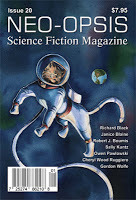 Blaine, Janice. Cover of Neo-opsis Science Fiction Magazine, Issue 20
Blaine, Janice. Cover of Neo-opsis Science Fiction Magazine, Issue 20
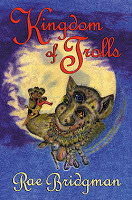 Bridgman, Rae. Interior illustrations for Kingdom of Trolls. (Sybertooth) February 2011.
Bridgman, Rae. Interior illustrations for Kingdom of Trolls. (Sybertooth) February 2011.
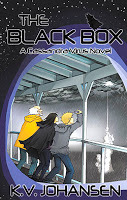 Choi, Connie. Cover art for The Black Box. (Sybertooth) February 2011.
Choi, Connie. Cover art for The Black Box. (Sybertooth) February 2011.
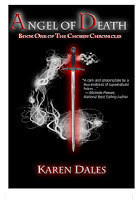 Dales, Evan. The cover art for Shadow of Death: Book Two of The Chosen Chronicles and the covers for the reissues of Changeling: Prelude to the Chosen Chronicles (May 2011) and Angel of Death: Book One of the Chosen Chronicles (May 2011) published by Dark Dragon Publishing
Dales, Evan. The cover art for Shadow of Death: Book Two of The Chosen Chronicles and the covers for the reissues of Changeling: Prelude to the Chosen Chronicles (May 2011) and Angel of Death: Book One of the Chosen Chronicles (May 2011) published by Dark Dragon Publishing
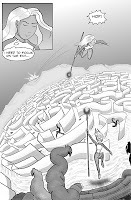 Laframboise, Michèle, Otaku Ladies, a cyberpunk Webcomic, since January 2011
Laframboise, Michèle, Otaku Ladies, a cyberpunk Webcomic, since January 2011
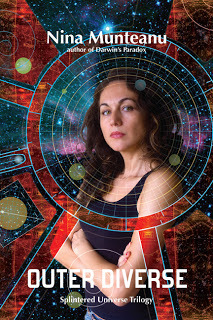 Gurgu, Costi. Cover art for Outer Diverse. (Starfire World Syndicate) October 2011. You can read a revealing interview of Costi and the process of creating cover design right here on The Alien Next Door.
Gurgu, Costi. Cover art for Outer Diverse. (Starfire World Syndicate) October 2011. You can read a revealing interview of Costi and the process of creating cover design right here on The Alien Next Door.
Now, go nominate!
It might be a little late to nominate written works you haven't yet read. But the advantage of the ARTISTIC ACHIEVEMENT category is that you just have to look at the artwork to make your choice.
So, here are the eligible artworks of five Canadian artists and cover designers who are currently eligible for an Aurora Award for ARTISTIC ACHIEVEMENT. Pick and NOMINATE!
 Blaine, Janice. Cover of Neo-opsis Science Fiction Magazine, Issue 20
Blaine, Janice. Cover of Neo-opsis Science Fiction Magazine, Issue 20 Bridgman, Rae. Interior illustrations for Kingdom of Trolls. (Sybertooth) February 2011.
Bridgman, Rae. Interior illustrations for Kingdom of Trolls. (Sybertooth) February 2011. Choi, Connie. Cover art for The Black Box. (Sybertooth) February 2011.
Choi, Connie. Cover art for The Black Box. (Sybertooth) February 2011. Dales, Evan. The cover art for Shadow of Death: Book Two of The Chosen Chronicles and the covers for the reissues of Changeling: Prelude to the Chosen Chronicles (May 2011) and Angel of Death: Book One of the Chosen Chronicles (May 2011) published by Dark Dragon Publishing
Dales, Evan. The cover art for Shadow of Death: Book Two of The Chosen Chronicles and the covers for the reissues of Changeling: Prelude to the Chosen Chronicles (May 2011) and Angel of Death: Book One of the Chosen Chronicles (May 2011) published by Dark Dragon Publishing Laframboise, Michèle, Otaku Ladies, a cyberpunk Webcomic, since January 2011
Laframboise, Michèle, Otaku Ladies, a cyberpunk Webcomic, since January 2011 Gurgu, Costi. Cover art for Outer Diverse. (Starfire World Syndicate) October 2011. You can read a revealing interview of Costi and the process of creating cover design right here on The Alien Next Door.
Gurgu, Costi. Cover art for Outer Diverse. (Starfire World Syndicate) October 2011. You can read a revealing interview of Costi and the process of creating cover design right here on The Alien Next Door. Now, go nominate!
Published on March 16, 2012 17:02
March 1, 2012
Should You Judge a Book by its Cover?
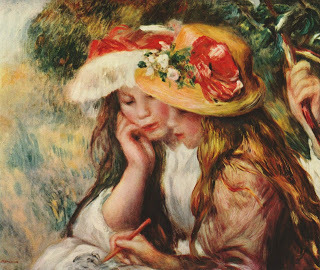 Most readers—me included—will pick a book off the bookstore shelf because its cover interests us: the title intrigues; the cover illustration attracts; the author's name is one we trust.
Most readers—me included—will pick a book off the bookstore shelf because its cover interests us: the title intrigues; the cover illustration attracts; the author's name is one we trust. If you don't know the author of the book, the nature—and implied promise—of the cover becomes even more important.
If the book does not deliver on the promise of the cover, it will fail with many readers despite its intrinsic value. A broken promise is still a broken promise. I say cover, not necessarily the back jacket blurb, because the front cover is our first and most potent introduction to the quality of the story inside. How many of us have picked up a book, intrigued by its alluring front cover, read the blurb that seemed to resonate with the title and image, then upon reading our cherished purchase been disillusioned with the story and decided we disliked it and its author?
This is because, as readers, from the moment we pick up a book, we engage in a covenant with the story's author (but in actual fact with the entire publishing company) for a story whose promise we have interpreted from its cover image, title and blurb. It begins with the cover. A book's cover is its sales pitch: "This is what I'm about!" the cover proclaims in shades of color and texture. The cover sets the tone and attitude with which a reader will interpret the book's title and back jacket blurb and its interior.
It had better be true.
Let me tell you a story…
Some time ago, a writer colleague of mine secured a New York agent—based on her excellent query and synopsis—for her imaginative dragon fantasy. The agent pitched the book to a large publishing company, who made my friend an offer, and the agent secured a three book deal on her behalf. My writing friend's career as a published author was launched.
Because the publishing company was one of the large firms, my friend's ability to participate—never mind influence—the cover design and blurb was restricted. Decisions lay in the hands of the people in the marketing department, who may or may not have read the book (most likely not). This is why it is so important to write a blurb/query/pitch that both scintillates AND accurately portrays the story. All too often, the marketing department misrepresents the story (to sell more books) and you end up with an unsatisfied reader. This is what happened to my friend. Through no fault of hers, the marketing people developed a cover that did not reflect the true nature of her story. The trilogy my friend had developed was a dark tale of deceit, betrayal and suffering. The cover portrayed a lively and sultry seductress, draped with flowing robes and bared thighs against her dragon; hardly the ponderous story shrouded within. The blurb at the back was sufficiently vague to aid and abet the deception.
What followed the book's launch and accompanying ad campaign was a barrage of bad reviews and censure, unfortunately aimed mostly at the author. It was unfortunate that my friend suffered the brunt of the accusations for breaking her promise to the readers, when she had done no such thing; her publisher and marketers had created false expectations. And now she was paying for it.
I, too, experienced the effects of mis-marketing. I'd written a dark science fiction romance that ended with resolution but was far from the traditional happy ending typical of a romance. The publisher marketed it as a romance with science fiction elements instead of a science fiction with romance elements. Reviewers applauded it but it bombed with romance readers, who expected a different kind of resolution. Science fiction readers, however, enjoyed it; they didn't have the same expectations.
The take home lesson for writers is this: write a scintillating but accurate synopsis, blurb, pitch and query that clearly establishes your genre and audience. Chances are your publishers will use it in their marketing department. If you don't get in with the "Big Boys", and decide to go with the small presses, chances are very good that you will have more control over marketing and cover design; that is a big bonus. If you are like me, creative control of your intellectual property is more important than the big bucks you get at the expense of your art. Don't give in to the temptations of wolf-marketing.
I'm still learning that lesson.
The take home lesson for readers is this: don't judge a book by its cover; certainly pick up the book if it looks interesting, then read with an open mind and let the story take you to where it needs to, despite what you may have expected from the false advertising. Chances are, the unexpected journey visited upon you may be a welcome surprise. And don't blame the writer for something he didn't have control over.
I'm still learning that lesson too.
Published on March 01, 2012 00:07
February 22, 2012
Finding the Courage to Write ... and Publish
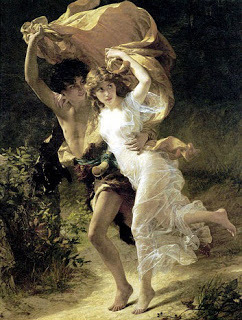 Are you afraid to write, to answer the call of your creative urges? Good. If you're not scared, you're not writing — Ralph Keyes
Are you afraid to write, to answer the call of your creative urges? Good. If you're not scared, you're not writing — Ralph Keyes"Being creative means giving yourself the freedom to be who you really are," says Nancy Slonim Aronie, author of Writing from the Heart: Tapping the Power of Your Inner Voice.
But that takes courage. A lot of courage.
Ralph Keyes, author of The Courage to Write, admits that "what makes writing so scary is the perpetual vulnerability of the writer. It's not the writing as such that provokes our fear so much as other people's reaction to our writing." In fact, adds Keyes, "the most common disguise is fear of them, their opinion of us, when it's actually our own opinion of ourselves that we're worried about." Keyes suggests that ultimately "mastering techniques [of style and craft] will do far less to improve writing than finding the will, the nerve, the guts to put on paper what you really want to say."
I was recently in Montreal at a writers' convention, launching my new book Outer Diverse along with several other authors and I recall one admitting to feeling terror when her first short story — whose main antagonist was based on her mother — was accepted by a magazine. Her first thought was: what have I done?
Says Keyes: "Any writing lays the writer open to judgment about the quality of his work and thought. The closer he gets to painful personal truths, the more fear mounts — not just about what he might reveal, but about what he might discover should he venture too deeply inside. But to write well, that's exactly where we must venture."
So, why do it, then? Why bother? Is it worth it to make yourself totally vulnerable to the possible censure and ridicule of your peers, friends, and relatives? To serve up your heart on a platter to just have them "drag it around" as Stevie Nicks would say…
Welcome to the threshold of your career as a writer. This is where many aspiring writers stop: in abject fear, not of failure but of "success". The only difference between those that don't and those that do, is that the former come to terms with their fears, in fact learn to use them as a barometer to what is important.
How do you get past the fear of being "exposed", past the anticipated disappointment of peers, past the terror of success?
The answer is passion.
If you are writing about something you are passionate about, you will find the courage to see it through. Says Keyes, "the best writing flows less from acquired skill than conviction expressed with courage. By this I don't mean moral convictions, but the sense that what one has to say is something others need to know."
This is ultimately what drives a writer to not just write but to publish: the need to share one's story, over and over again. To prevail, persist, and ultimately succeed, a writer must have conviction and believe in his or her writing. You must believe that you have something to say that others want to read. Ask yourself why you are a writer. Your answer might surprise you.
Every writer is an artist. And every artist is a cultural reporter, whose business is to report the truth and sometimes hold a culture accountable.
"Real art," says Susan Sontag, "makes us nervous."
The first step is to acknowledge your passion and own it. Flaunt it, even. Find your conviction, define what matters and explore it to the fullest. You will find that such an acknowledgement will give you the strength and fortitude to persist and persevere, particularly in the face of those fears. Use the fears to guide you into that journey of personal truths. Frederick Busch described it this way: "You go to dark places … to steal the trophy and get out." You are the hero.
Every writer, like his or her protagonist, is on a Hero's Journey. Like the Hero of our epic, we too must acknowledge the call, pass the threshold guardian, maneuver the abyss and face the beast before we can return "home" with our prize.
"If you long to excel as a writer," says Finke, "treasure the passion that is unique within yourself. Take the irreplaceable elements of your life and craft them into your own personal contribution to the world." And worry about the rest later.
Published on February 22, 2012 13:19
February 1, 2012
Costi Gurgu Interview and the Auroras

full cover art for Outer Diverse
When I first met Costi and Vali Gurgu at the World Fantasy Convention in Montreal several years ago, I had no idea that Costi would end up creating the stunning book covers for my latest Splintered Universe Trilogy or that his gorgeous wife, Vali, would serve as the model for the hero of my story, the relentless and steely detective, RHEA HAWKE. You can find his cover art and other artworks on Costi's illustration site.
I recently had a chance to invite Costi aboard my intelligent ship, Benny, orbiting the Earth. After settling in the aft lounge with some pockta juice, we began the interview:
Nina: Hi, Costi. Thanks so much for agreeing to do this interview.
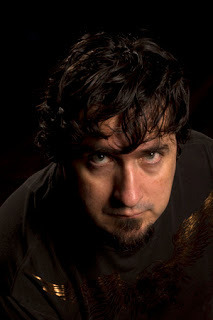
Costi Gurgu
Costi: Hi, Nina. The pleasure is mine.
Nina: You came up with a "Triptych" design for the Splintered Universe Trilogy. What inspired you to come up with it and what do you like about it?
Costi: There is the danger of spoilers in this answer. The fact is that your main character, Rhea, undergoes a certain evolution from a regular human being to… let's just say something else. And that evolution has three parts, one for each book of the trilogy and it also has a touch of divine. So, the triptych design, so often used for religious paintings, fits like a glove on the entire concept.
Nina: Ooh! Neat! Where can I get a copy? … (grin) … Your design for Outer Diverse (and designs for the other two covers) carries a powerful image that conjures a portal or gateway into another world (which is what the trilogy is about). The reader is drawn into an infinite landscape, looking in, and Rhea is looking out. Can you tell us a little about how you conceived this compelling design. Is there a meaning behind the symbols and colours you used?
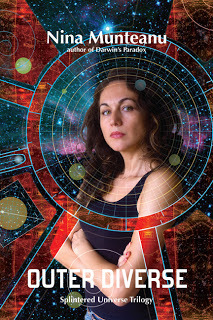
front cover design for Outer Diverse
Costi: To be honest, the initial idea was for the red ring to be a sort of mapping device and a radar combined into one, since Rhea travels great distances in her quest. Then I realized it might as well be a portal device on top of everything else and serve all her travelling needs.
There were two options —either we would look with her outside, to whatever target she had, or look towards her. I thought that it would be more powerful if we could look towards her and see her determined face, see the unflinching resolution in her eyes, while she's pondering her next move and readying herself to use the device once again. But to look towards her and see her in a confining room of a space ship, or such, would have defeated the purpose. So I needed to have her against the infinite landscape as the backdrop. She is in a continuous journey to discover herself and this journey takes her literally through the infinite spaces of not just one universe.
Nina: Yes, I love the metaphoric elements you've woven into the design. The image speaks to us on many levels. Do you use music or other devices in your work to evoke your creativity? What other tools did you use to create the stunning cover of Outer Diverse (e.g., animation software, etc.)?
Costi: I'm always listening to music while working. The kind of music varies depending on what I'm working on. If I'm writing for instance, I need instrumental music, without words to influence my own ones. Also, it depends on the kind of feeling and mood I try to generate through my writing or my illustration. Music helps me channel those feelings into the right words or imagery.

Vali Gurgu as RHEA HAWKE
Technically speaking, I always start with sketches on paper, which I later scan. I mainly use Adobe Photoshop, but for this illustration I had to use Adobe Illustrator as well. Obviously, the layout and the typography were done in Adobe InDesign.
Nina: Your wife, Vali, was the model for Rhea Hawke. I understand you had a great time doing the photo-shoot (p.s., some of the additional shoots can be seen in the Youtube book trailer). I've attended several launches and events lately (e.g., Halifax, Montreal, Toronto, Vancouver, and Bucharest) and both cover and model have been extolled. One reader compared Vali to actress Catherine Zeta Jones. How does Vali feel about being somewhat of a celebrity?
Costi: I'm so happy to hear that. You know, I had to decide how to treat her image. I could have gone towards a more glamorous, shiny look, like in a fashion image, or I could just simply keep it more realistic. Despite Vali's protests, I chose to keep it that way, because I wanted to offer a realistic image of an ex-police officer: a woman who was used to fighting and chasing criminals, rather than taking care of her appearances. Now, to hear that her rougher and tougher image created that kind of reaction gives me a sort of peace and satisfaction.
As for the celebrity thing, so far we only heard that from you. Not that we don't believe you! We'll see when it really happens in her presence. It's always a good feeling to taste a little bit of celebrity now and then. It certainly gives one purpose and perspective. Not to mention hope.
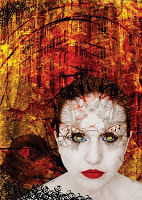
Costi Gurgu cover art
Nina: You and Vali have had rich and varied careers in commercial art, law and writing. You've served, for instance, as art director for several high-end magazines including Playboy, and you taught graphic design at the college level. Can you tell me a little about your journey from Romania to England and finally to Toronto, Canada. Did the law degree help you in your entrepreneurial pursuits?
Costi: Well, yes, ironically the law degree took us places. We both loved studying law. It had a unique way of opening our eyes to culture, civilization and the importance of continuously learning. Yet, while we loved studying law, we hated practicing it. After our first year of articling in Bucharest' Law Bar Association, we didn't like what we were doing, but more importantly, we didn't like the people we were turning into.
Therefore, we decided to change tracks and try something a bit different. We left for England, hoping we'd get into some Master degree in Maritime Law. So, here we are, at "Open Day" at Westminster College in London. We'd enrolled for some English classes and saw a crowd at one of the Graphic Design Program tables. Some Photoshop wizard was doing a demonstration. For our untrained eye it was absolutely wonderful! We started asking questions and the "wizard" encouraged us to take his class. I don't remember what it was called, "Digital Manipulation" or something. We replied that we're there for Law studies, so he said—well, why don't you take my class just for fun? So, we did and by the end of the semester we enrolled for the Graphic Design Certificate and forgot everything about Maritime Law or any other kind of Law. We'd just discovered the wonderful world of design, illustration, art direction and photography!
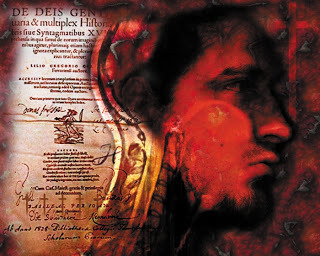
Costi Gurgu cover art
Nina: That's COOL! Did you pursue illustration and design in England?
Costi: Well, three years later saw us going back to Romania; our families expected us to go back to the Bar Association and behave responsibly. But after showing my portfolio around I got a designer job at Playboy Magazine! The Art Director and I launched its first Romanian edition issue a few months later. Three years later I became the Creative Director of MediaPro Group, the largest publishing company in Romania and Vali took on the position of Art Director of Playboy Magazine.
Two years later we came to Canada to pursue a dream. So, yes, I could say that my law degree created the perfect opportunity for me to discover my passions for visual arts. It took me to England and eventually to Canada. Life is funny that way.
Nina: Does Vali help you with your work and do you help her with hers?
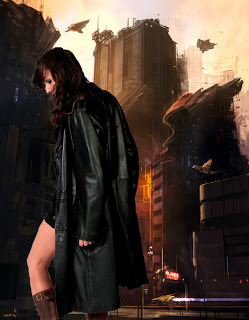
brooding RHEA HAWKE
Costi: We help each other a lot in our work. Because we worked together in our first legal job and after that in our first design job, we have become a team. We have different approaches to the art process and we have different styles. I went deeper into illustration to complement my design skills, while she chose photography to do that.
Even now, for the most important projects we have for our different employers we involve each other not only for need of feedback, but also for need of different ideas and fresh approaches. We basically complement each other.
Not to mention that she's always my first reader for any piece of fiction I write. She's the toughest reader I have but in the same time I know she's also the most sincere one.
Nina: Name some artists and their cover designs that you like and why. How would you describe your own artwork (e.g., magazine and book covers)? Who are your influences?
Costi: Where should I begin? I always loved the paintings of Rene Magritte and Giorgio de Chirico. I also have to mention Dali and H.R. Giger. They're just incredibly good and inspirational.
I can't miss Neville Brody, one of the most famous and brilliant designers of all time. Not too many book covers, but you have to look for his music album covers and typography compositions, and magazine covers. He's done a lot of covers for the legendary The Face Magazine. You have to see the book The Graphic Language of Neville Brody. Absolutely beautiful.
Special mention goes to Edward Gorey. His art is amazing.
From the usual suspects of SF&F artists, I like Michael Whelan, especially his horror covers. See for instance Lovecraft's Nightmare, both parts, or some of his personal studies. I like Frank Frazetta and Rodney Matthews. And there are others, many others, the list would be just too long for the purpose of this interview.
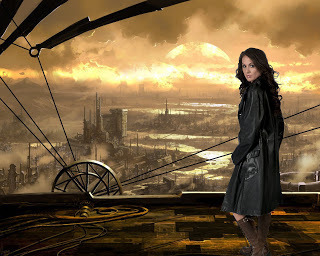
RHEA HAWKE
Nina: Costi, your artwork on Outer Diverse is eligible in the Art Category for an Aurora Prix and the Hugo, the Canadian and American prizes for work in the science fiction and fantasy fields, respectively. How does that make you feel?
Costi: I try not to get my hopes too high. It's a long way from eligibility to winning. But just to be in the game really feels good. From another perspective, it's part of my dream coming true. It's part of my journey and the reason I'm here. It's so good to be noticed and to exist outside your family's and friends' awareness.
Nina: Speaking of…when I was in Bucharest recently to launch my fiction writing textbook at the Gaudeamus Book Fair, I heard a lot about this guy Costi Gurgu, a rather well known and accomplished writer in Romania. You've sold five books and over forty short stories in Romania and won over twenty awards. Tell me about this guy, Costi the writer. What have you written and where can we find it?
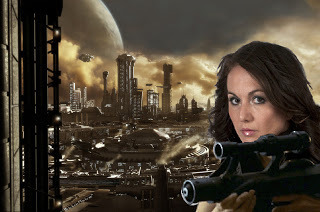
RHEA HAWKE on the hunt
Costi: In truth, half of my reason for coming to Canada is related to my writing.
I made my debut in Romania, in 1993 and since then I published constantly in magazines and anthologies. I edited three anthologies. I won each and every award there was in Romania, several times. Among those, I won the prestigious Vladimir Colin Award twice (for my first story collection and for my first novel), and the Writers Union Award (a literary award) for the debut for my first book, a story collection entitled The Glass Plague.
My stories have been published in Romania, Hungary, Poland, Denmark, England, Canada and USA.
My latest sales have been to the Danish anthology Creatures of Glass and Light, the Daw Books anthology Ages of Wonder, Wildside Press anthology The Science Fiction Megapack, Millennium Books steampunk anthology The Second Revolution, and the anthology Voices—New Writers from Toronto, published by Co-op Writers and Toronto Public Library.
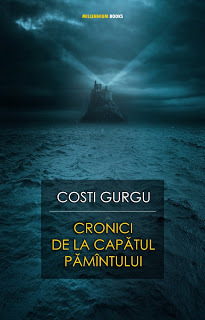 Nina: What are you working on now—besides more covers for my Splintered Universe Trilogy, that is?
Nina: What are you working on now—besides more covers for my Splintered Universe Trilogy, that is?
Costi: A few months ago I launched my latest book in Romania, another story collection, entitled Chronicles from the End of the Earth. I'm working on the English version of some of the stories in that collection.
Right now I'm writing a horror story for an anthology from Romania. I'm also in the middle of my new novel, for which I don't even have a working title. All I know for now is that it has magic and it has science and some bits of dark happenings, so it will probably be a cross-genre. It is also supposed to be the first book of my first trilogy.
I'm thinking of a comedy movie script for next year. I've never tried a movie script, but I'd really like to write one.
Nina: Sounds like fun, Costi! With your sense of humor, it should be a great success. Thanks so much for joining us here on Benny. I wish you the best of luck in the Auroras and the Hugos and in all your writing and illustration projects. It's been an honor to work with you.
Costi: Again, my pleasure, Nina. And thanks for the Plockta nectar. It was … eh … interesting.
…See? He's so polite!
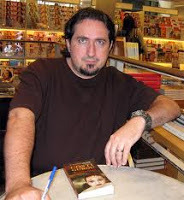
Costi Gurgu
If you love art and agree with me that Costi's stunning artwork on Outer Diverse merits recognition, please share this post with your friends on Facebook, Twitter, Linked-In and elsewhere.
Better yet, NOMINATE Costi for the PRIX AURORA in the "Best Artist" category (if you're a Canadian). You have until March 31st to nominate.
Just as good, RECOMMEND his exemplary cover art for a HUGO AWARD in the category of "Best Professional Artist". Third Party Sites where you can recommend Costi's cover art include: Live Journal Community; NESFA, and SF Awards Watch.
If you're already a member of the World Science Fiction Convention, you can NOMINATE Costi for a HUGO. You have until March 11 to nominate.
Outer Diverse is for sale at Amazon.ca, Amazon.com, Amazon.co.uk and Barnes & Noble as well as other quality bookstores near you. It is also eligible for an Aurora. The Splintered Universe trilogy follows the turbulent career of galactic guardian Rhea Hawke, whose unswerving passion for justice though faulty vision of the world collide in ways unimaginable as she searches for answers to a spiritual massacre. Visit this page for more details about the trilogy.

full cover art for Outer Diverse
When I first met Costi and Vali Gurgu at the World Fantasy Convention in Montreal several years ago, I had no idea that Costi would end up creating the stunning book covers for my latest Splintered Universe Trilogy or that his gorgeous wife, Vali, would serve as the model for the hero of my story, the relentless and steely detective, RHEA HAWKE. You can find his cover art and other artworks on Costi's illustration site.
I recently had a chance to invite Costi aboard my intelligent ship, Benny, orbiting the Earth. After settling in the aft lounge with some pockta juice, we began the interview:
Nina: Hi, Costi. Thanks so much for agreeing to do this interview.

Costi Gurgu
Costi: Hi, Nina. The pleasure is mine.
Nina: You came up with a "Triptych" design for the Splintered Universe Trilogy. What inspired you to come up with it and what do you like about it?
Costi: There is the danger of spoilers in this answer. The fact is that your main character, Rhea, undergoes a certain evolution from a regular human being to… let's just say something else. And that evolution has three parts, one for each book of the trilogy and it also has a touch of divine. So, the triptych design, so often used for religious paintings, fits like a glove on the entire concept.
Nina: Ooh! Neat! Where can I get a copy? … (grin) … Your design for Outer Diverse (and designs for the other two covers) carries a powerful image that conjures a portal or gateway into another world (which is what the trilogy is about). The reader is drawn into an infinite landscape, looking in, and Rhea is looking out. Can you tell us a little about how you conceived this compelling design. Is there a meaning behind the symbols and colours you used?

front cover design for Outer Diverse
Costi: To be honest, the initial idea was for the red ring to be a sort of mapping device and a radar combined into one, since Rhea travels great distances in her quest. Then I realized it might as well be a portal device on top of everything else and serve all her travelling needs.
There were two options —either we would look with her outside, to whatever target she had, or look towards her. I thought that it would be more powerful if we could look towards her and see her determined face, see the unflinching resolution in her eyes, while she's pondering her next move and readying herself to use the device once again. But to look towards her and see her in a confining room of a space ship, or such, would have defeated the purpose. So I needed to have her against the infinite landscape as the backdrop. She is in a continuous journey to discover herself and this journey takes her literally through the infinite spaces of not just one universe.
Nina: Yes, I love the metaphoric elements you've woven into the design. The image speaks to us on many levels. Do you use music or other devices in your work to evoke your creativity? What other tools did you use to create the stunning cover of Outer Diverse (e.g., animation software, etc.)?
Costi: I'm always listening to music while working. The kind of music varies depending on what I'm working on. If I'm writing for instance, I need instrumental music, without words to influence my own ones. Also, it depends on the kind of feeling and mood I try to generate through my writing or my illustration. Music helps me channel those feelings into the right words or imagery.

Vali Gurgu as RHEA HAWKE
Technically speaking, I always start with sketches on paper, which I later scan. I mainly use Adobe Photoshop, but for this illustration I had to use Adobe Illustrator as well. Obviously, the layout and the typography were done in Adobe InDesign.
Nina: Your wife, Vali, was the model for Rhea Hawke. I understand you had a great time doing the photo-shoot (p.s., some of the additional shoots can be seen in the Youtube book trailer). I've attended several launches and events lately (e.g., Halifax, Montreal, Toronto, Vancouver, and Bucharest) and both cover and model have been extolled. One reader compared Vali to actress Catherine Zeta Jones. How does Vali feel about being somewhat of a celebrity?
Costi: I'm so happy to hear that. You know, I had to decide how to treat her image. I could have gone towards a more glamorous, shiny look, like in a fashion image, or I could just simply keep it more realistic. Despite Vali's protests, I chose to keep it that way, because I wanted to offer a realistic image of an ex-police officer: a woman who was used to fighting and chasing criminals, rather than taking care of her appearances. Now, to hear that her rougher and tougher image created that kind of reaction gives me a sort of peace and satisfaction.
As for the celebrity thing, so far we only heard that from you. Not that we don't believe you! We'll see when it really happens in her presence. It's always a good feeling to taste a little bit of celebrity now and then. It certainly gives one purpose and perspective. Not to mention hope.

Costi Gurgu cover art
Nina: You and Vali have had rich and varied careers in commercial art, law and writing. You've served, for instance, as art director for several high-end magazines including Playboy, and you taught graphic design at the college level. Can you tell me a little about your journey from Romania to England and finally to Toronto, Canada. Did the law degree help you in your entrepreneurial pursuits?
Costi: Well, yes, ironically the law degree took us places. We both loved studying law. It had a unique way of opening our eyes to culture, civilization and the importance of continuously learning. Yet, while we loved studying law, we hated practicing it. After our first year of articling in Bucharest' Law Bar Association, we didn't like what we were doing, but more importantly, we didn't like the people we were turning into.
Therefore, we decided to change tracks and try something a bit different. We left for England, hoping we'd get into some Master degree in Maritime Law. So, here we are, at "Open Day" at Westminster College in London. We'd enrolled for some English classes and saw a crowd at one of the Graphic Design Program tables. Some Photoshop wizard was doing a demonstration. For our untrained eye it was absolutely wonderful! We started asking questions and the "wizard" encouraged us to take his class. I don't remember what it was called, "Digital Manipulation" or something. We replied that we're there for Law studies, so he said—well, why don't you take my class just for fun? So, we did and by the end of the semester we enrolled for the Graphic Design Certificate and forgot everything about Maritime Law or any other kind of Law. We'd just discovered the wonderful world of design, illustration, art direction and photography!

Costi Gurgu cover art
Nina: That's COOL! Did you pursue illustration and design in England?
Costi: Well, three years later saw us going back to Romania; our families expected us to go back to the Bar Association and behave responsibly. But after showing my portfolio around I got a designer job at Playboy Magazine! The Art Director and I launched its first Romanian edition issue a few months later. Three years later I became the Creative Director of MediaPro Group, the largest publishing company in Romania and Vali took on the position of Art Director of Playboy Magazine.
Two years later we came to Canada to pursue a dream. So, yes, I could say that my law degree created the perfect opportunity for me to discover my passions for visual arts. It took me to England and eventually to Canada. Life is funny that way.
Nina: Does Vali help you with your work and do you help her with hers?

brooding RHEA HAWKE
Costi: We help each other a lot in our work. Because we worked together in our first legal job and after that in our first design job, we have become a team. We have different approaches to the art process and we have different styles. I went deeper into illustration to complement my design skills, while she chose photography to do that.
Even now, for the most important projects we have for our different employers we involve each other not only for need of feedback, but also for need of different ideas and fresh approaches. We basically complement each other.
Not to mention that she's always my first reader for any piece of fiction I write. She's the toughest reader I have but in the same time I know she's also the most sincere one.
Nina: Name some artists and their cover designs that you like and why. How would you describe your own artwork (e.g., magazine and book covers)? Who are your influences?
Costi: Where should I begin? I always loved the paintings of Rene Magritte and Giorgio de Chirico. I also have to mention Dali and H.R. Giger. They're just incredibly good and inspirational.
I can't miss Neville Brody, one of the most famous and brilliant designers of all time. Not too many book covers, but you have to look for his music album covers and typography compositions, and magazine covers. He's done a lot of covers for the legendary The Face Magazine. You have to see the book The Graphic Language of Neville Brody. Absolutely beautiful.
Special mention goes to Edward Gorey. His art is amazing.
From the usual suspects of SF&F artists, I like Michael Whelan, especially his horror covers. See for instance Lovecraft's Nightmare, both parts, or some of his personal studies. I like Frank Frazetta and Rodney Matthews. And there are others, many others, the list would be just too long for the purpose of this interview.

RHEA HAWKE
Nina: Costi, your artwork on Outer Diverse is eligible in the Art Category for an Aurora Prix and the Hugo, the Canadian and American prizes for work in the science fiction and fantasy fields, respectively. How does that make you feel?
Costi: I try not to get my hopes too high. It's a long way from eligibility to winning. But just to be in the game really feels good. From another perspective, it's part of my dream coming true. It's part of my journey and the reason I'm here. It's so good to be noticed and to exist outside your family's and friends' awareness.
Nina: Speaking of…when I was in Bucharest recently to launch my fiction writing textbook at the Gaudeamus Book Fair, I heard a lot about this guy Costi Gurgu, a rather well known and accomplished writer in Romania. You've sold five books and over forty short stories in Romania and won over twenty awards. Tell me about this guy, Costi the writer. What have you written and where can we find it?

RHEA HAWKE on the hunt
Costi: In truth, half of my reason for coming to Canada is related to my writing.
I made my debut in Romania, in 1993 and since then I published constantly in magazines and anthologies. I edited three anthologies. I won each and every award there was in Romania, several times. Among those, I won the prestigious Vladimir Colin Award twice (for my first story collection and for my first novel), and the Writers Union Award (a literary award) for the debut for my first book, a story collection entitled The Glass Plague.
My stories have been published in Romania, Hungary, Poland, Denmark, England, Canada and USA.
My latest sales have been to the Danish anthology Creatures of Glass and Light, the Daw Books anthology Ages of Wonder, Wildside Press anthology The Science Fiction Megapack, Millennium Books steampunk anthology The Second Revolution, and the anthology Voices—New Writers from Toronto, published by Co-op Writers and Toronto Public Library.
 Nina: What are you working on now—besides more covers for my Splintered Universe Trilogy, that is?
Nina: What are you working on now—besides more covers for my Splintered Universe Trilogy, that is?Costi: A few months ago I launched my latest book in Romania, another story collection, entitled Chronicles from the End of the Earth. I'm working on the English version of some of the stories in that collection.
Right now I'm writing a horror story for an anthology from Romania. I'm also in the middle of my new novel, for which I don't even have a working title. All I know for now is that it has magic and it has science and some bits of dark happenings, so it will probably be a cross-genre. It is also supposed to be the first book of my first trilogy.
I'm thinking of a comedy movie script for next year. I've never tried a movie script, but I'd really like to write one.
Nina: Sounds like fun, Costi! With your sense of humor, it should be a great success. Thanks so much for joining us here on Benny. I wish you the best of luck in the Auroras and the Hugos and in all your writing and illustration projects. It's been an honor to work with you.
Costi: Again, my pleasure, Nina. And thanks for the Plockta nectar. It was … eh … interesting.
…See? He's so polite!

Costi Gurgu
If you love art and agree with me that Costi's stunning artwork on Outer Diverse merits recognition, please share this post with your friends on Facebook, Twitter, Linked-In and elsewhere.
Better yet, NOMINATE Costi for the PRIX AURORA in the "Best Artist" category (if you're a Canadian). You have until March 31st to nominate.
Just as good, RECOMMEND his exemplary cover art for a HUGO AWARD in the category of "Best Professional Artist". Third Party Sites where you can recommend Costi's cover art include: Live Journal Community; NESFA, and SF Awards Watch.
If you're already a member of the World Science Fiction Convention, you can NOMINATE Costi for a HUGO. You have until March 11 to nominate.
Outer Diverse is for sale at Amazon.ca, Amazon.com, Amazon.co.uk and Barnes & Noble as well as other quality bookstores near you. It is also eligible for an Aurora. The Splintered Universe trilogy follows the turbulent career of galactic guardian Rhea Hawke, whose unswerving passion for justice though faulty vision of the world collide in ways unimaginable as she searches for answers to a spiritual massacre. Visit this page for more details about the trilogy.
Published on February 01, 2012 08:39
January 25, 2012
How Are You Telling Your Story?...Part 2: Voice and Narration
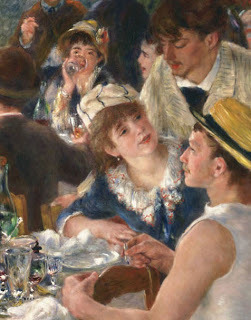 The term "Voice" describes various aspects of a writer's expression in story; it includes your unique writing style and the style you've chosen to adopt for the particular story you're telling. The voice of your story is influenced by your audience—youth, adults, crazy people, etc.—as well as the subject matter and general overall theme of the story.
The term "Voice" describes various aspects of a writer's expression in story; it includes your unique writing style and the style you've chosen to adopt for the particular story you're telling. The voice of your story is influenced by your audience—youth, adults, crazy people, etc.—as well as the subject matter and general overall theme of the story.Voice is the feel and tone that applies to: 1) the story or book (narrative voice); 2) to each character in that story; and 3) the author's own voice (authorial voice; in business it's called the brand), which you carry with you in every work. It is the combination of all these "voices" that make each of your works unique. Think of a fine artist, a painter like Vincent Van Gogh, whose unique painter's "voice" was apparent in all his Impressionistic works. The wild swirls of light and texture characterized all his paintings; yet, each individual work expressed its own unique message in Van Gogh's artistic journey.
Authorial Voice
You express your authorial voice and the voice of your story through tone, perspective, style, language and pace. All of these reflect your intent and are ultimately expressed in the story's overarching theme. The overarching theme is ultimately the author's theme, the "world view" — the "so what part" — of the story. The principal character and minor characters will carry variations of the main theme, each with his or her unique voice. Invariably, the voice of the story reflects the author's philosophy, biases and message.
Writers generally struggle in the beginning to obtain their unique "voice", often adopting the voice of a writer they admire. Although this can help a writer define their own voice (by illuminating what they like and strive for), it can also retard an author's unique self-expression. It is so much easier to use another's proven formula; the danger is that you may never escape from beneath the shadow of your hero. In the area of science fiction, which I write, the internet is rich with "fan fic" (an endearing term for works based on already established stories, worlds, characters, and styles.) Many fan fic writers will not emerge from the shadow of unoriginality to find their own voice. So, take heed and be mindful of your own voice. Determine what is important to you and you will find your voice.
Narrative Voice
Narrative voice belongs to the persona telling the story. Which persona you adopt in narration depends on what kind of story you are telling, and the kind of emotional atmosphere you wish to achieve, says Crawford Kilian, Canadian author of over a dozen novels. The persona develops from the personality and attitude of the narrator, expressed through the narrator's choice of words and depictions. Depending on your choice of POV (see my previous article on Viewpoint), the narrator of your story can be one or several main characters or you, the writer. More on this below.
Character Voice
It's important to give each character a distinctive "voice" (including use of distinct vernacular, use of specific expressions or phrases, etc.). This is one way a reader can identify a character and find them likeable—or not.
In a manuscript I recently reviewed, I noticed that the characters spoke in a chaotic mixture of formal and casual speech. This confuses the reader and bumps them out of the story. Each person's speech is typically consistent, reflecting their ethnic and regional background, who they hang around with, their education, history and biases. Consistency is critical; it helps readers identify with a character. They will abandon a story whose writing—and voice—is not consistent. So, my advice to this beginning writer was to pick one style for each character and stick to it.
Voice incorporates language (both speech and body movements), philosophy, and humor. How a character looks, walks, talks, laughs, is all part of this. Let's take laughter for instance: does your character tend to giggle, titter, chortle, guffaw, belly-laugh? Does she usually put her hand over her mouth when she does? Does she do or say certain things when she's nervous? See my upcoming article on body language for more detail.
Who Should Tell the Story?
When telling a story through the eyes of a single viewpoint character, it makes most sense to tell it through the main character, the protagonist, around whom the story usually revolves. She is the one who's going to be chiefly affected by the events of the story. Ansen Dibell, author of The Elements of Fiction: Plot, asks the question: "Who is really at the story's heart?" If you're having trouble with the story of Sally and Norman from Sally's point of view, perhaps you should try telling it through Norman's point of view. Or perhaps your main POV character is a third person, looking on and, in turn, changed.
Narrating a story from an outsider's viewpoint (the hidden protagonist as observer-narrator) —sometimes called displaced narrative — can also add an element of complexity and depth to a story. The Illusionist is a good example of this. This story, about Eisenheim (the Illusionist) and his beloved, is told through the cynical eyes of the city's chief inspector, who learns to believe again through his "experience" of their story. Other examples include J.P. Hartley's The Go-Between, Scott Fitzgerald's The Great Gatsby, Saving Private Ryan, My Beloved, Charlotte Bronte's Wuthering Heights, and Joanne Harris's Chocolat.
Using a displaced viewpoint character to narrate a story works particularly well if you want to keep your main character strange and mysterious. Having an "outside" character tell the story of one or two other characters, also gives the writer a chance to add another thematic element to a story (the one belonging to the narrator). A story told through the eyes of a dreamer will be very different than one told by a ponderous thinker.
Other kinds of narration include:
• detached autobiography (narrator looks back on long-past events; e.g., To Kill a Mockingbird by Harper Lee)
• letters or diary (narrative told through letters, also known as the epistolary novel; e.g. my short story, Arc of Time)
• interior monologue (narrator recounts the story as a memory; stream of consciousness is an extreme form of this narrative, e.g., Ulysses by James Joyce)
How Many Should Tell the Story?
The use of multiple viewpoints is common among writers and adds an element of richness and breadth to a story. With each added character's POV, readers are more enlightened to the thoughts and motivations of characters in a story. When you have several characters telling the story, this is called a rotating viewpoint. A few points to follow include:
• Alternate or rotate your differing viewpoints clearly (scene by scene, chapter by chapter, or part by part)
• Don't change viewpoints within a scene
• Separate different POV scenes within chapters with extra white space or some kind of graphic (e.g., ****)
References
Dibell, Ansen. 1999. Elements of Fiction Writing: Plot. Writer's Digest Books. Cincinnati, Ohio. 170pp.
Killian, Crawford. 2003. "Narrative Voice". In: Writing Fiction: http://crofsblogs.typepad.com/fiction... voice.html
Munteanu, Nina. 2009. The Fiction Writer: Get Published, Write Now! Starfire World Syndicate. Louisville, KY. 266pp.
Published on January 25, 2012 13:42
January 18, 2012
How Are You Telling Your Story?...Part 1: Viewpoint
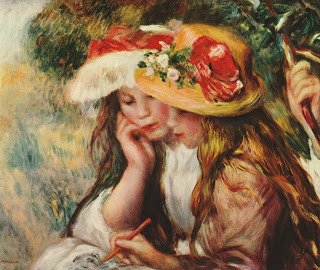 The story's viewpoint can be told from several perspectives and which one you choose can be critical to how your story comes across.
The story's viewpoint can be told from several perspectives and which one you choose can be critical to how your story comes across. Different stories lend themselves to different narrative styles and point of views (POVs). In his April 2000 article in Fiction Writer entitled "First Blood, Third Person" David Morrell warns that some writers may "select a viewpoint merely because it feels natural, but if you…don't consider the implications of your choice…your story might fight you until you abandon it, blaming the plot when actually the problem is how you're telling it."
The viewpoint choices include:
• Omniscient
• Third person limited
• Second person
• First person
Omniscient View
The omniscient view is the broadest view. Through this viewpoint the narrator describes everything and everyone and may drop into any character at any time, and — in the case of a beginning writer — all too confusingly in the same paragraph.
While this POV is the easiest one to use it is really the hardest to master. In the wrong hands, this viewpoint can be as intrusive as it is distancing. And it is prone to polemic. In the hands of a masterful writer, this viewpoint can make for the most powerful and rich storytelling. Epics of any kind, especially epic fantasies or historical epics, lend themselves to this style. The omniscient viewpoint is particularly suited to a story that is "large", where ultimately the main character is not any particular protagonist but "the story" itself, or a society or world or time period. The writer must still somehow achieve connection and intimacy with the reader to succeed with this viewpoint. You can do this through lyrical and compelling narrative, poetic language and powerful imagery.
Limited Third Person Viewpoint
A story told through limited third person POV is narrated from one or a few key characters (though not at the same time) by revealing not only their movements but their thoughts and feelings (e.g., he struggled up to his feet, giddy with pain). When starting out, it is often best to adopt this style, which is generally more personal, appealing and least confusing. So long as you respect the readers' need for clarity by keeping to one POV per scene, you can choose to enter into the heads of as many characters as you wish. It is the norm to use chapter, section or scene breaks when changing from one POV to another.
This style of narrative is the most common one used in contemporary books, particularly genre books, thrillers and action/adventure books. Through conflicting perspectives of your characters, you can swiftly paint a rich tapestry of tension for both characters and reader.
Second Person Viewpoint
This second person viewpoint ("you") is not often used, mostly because it is both distancing and less easy to read. Although it is a narrative often used in conversation (e.g., "you never know what you're gonna get with a box of chocolates, do you?") this style of narrative is harder for readers to embrace and get close to the story's characters. This viewpoint works effectively in certain artistic situations when you wish to purposefully impart a distance to the narrator, due to their own limitations, infirmity or situation.
First Person Viewpoint
The first person point of view is both the most limiting perspective (told only through one viewpoint) and most personal and revealing (of that viewpoint character). This viewpoint works well in literary fiction where the main character's thoughts and issues are the key focus in the story. When the character who changes the most is the one telling the story, this makes for very compelling reading.
Many detective stories are told in first person to great effect. The reader is right there with the detective, solving the mystery. The first person viewpoint is also the preferred POV for memoirs, for obvious reasons.
One thing to keep in mind, particularly when narrating through the first person POV, is the reliability of your character. You need to decide how reliable your first person POV character is in telling the story and how you will impart this to the reader. Writing through a character's faulty perception of the world (and of themselves) provides a writer with an incredible opportunity but also an incredible challenge. You can only go so far with an unreliable character before losing your own credibility as a writer — and losing the reader in the long run. Obviously, you need a balance.
If you are struggling with your story and can't quite pinpoint what is bogging it down, try changing how you are telling it. Change the viewpoint and see what happens.
Published on January 18, 2012 18:18
January 1, 2012
2011: Love in the Time of Chaos
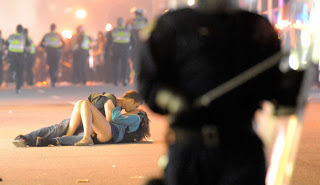 If you were asked to sum up 2011 in one photo which one would you choose?
If you were asked to sum up 2011 in one photo which one would you choose? When I made the decision to distill the past year into one quintessential "moment" captured in a photograph, I was faced with a multitude of choices. I could have chosen a photo that captured any number of significant events from the personal to the global:
… from the decision to re-adopt my male cat to the global nuclear crisis that originated in Japan. There was also "Arab Spring" when oppressed citizens toppled long-standing regimes and sent government officials fleeing, from a street vendor's fatal protest in Tunisia to the bloodless coup in Egypt and civil war in Libya. Japan suffered major earthquakes, a tsunami and resulting nuclear crisis. U.S. commandos assassinated Osama bin Laden. Prince William married Kate Middleton at Westminster Abbey. Steve Jobs succumbed to cancer at 56. Greeks, Italians and British rioted in the streets against unfair government policies while these same countries struggled with the threat of bankruptcy. After recovering from being shot in the head, Representative Gabrielle Gifford returned to office. Thanks to social networking, "Occupy Wall Street" spread from New York City to the entire world with the synchronicity and potency of a self-organized virus. Indeed, one Egyptian activist described it this way: "we use Facebook to schedule the protests, Twitter to coordinate, and YouTube to tell the world."
I chose none of these events; instead, I chose a young couple lying on the street, locked in a passionate kiss — oblivious to the charging crowd and the riot police struggling to contain them.
It is a powerful demonstration of how, amid the rubble of violence, love focuses us.
The photo was taken by photojournalist Richard Lam after a Stanley Cup hockey game in Vancouver. Amid the chaos of violence, looting and destruction and himself buffeted by riot police, Lam didn't even realize what he'd shot until his editor later pointed out that the two people weren't hurt but kissing. It was incredibly surreal because of its paradoxical nature.
Even though Lam didn't overtly recognize what he'd witnessed and captured on camera until it was pointed out to him, he'd felt it and participated in it. A defining fractal moment. When what we are and what we do focuses into one remarkable moment. The photo went viral on the internet hours after it was posted.
Perusing the various online news sites and blogs, I was struck by some of the comments, particularly by those who questioned whether the photo and associated story was newsworthy. The young man who was found and identified as Scott Jones of Perth later revealed that they had been knocked down by the riot police and he was just trying to calm down his girlfriend, Alexandra Thomas, a recent graduate of the University of Guelph in Ontario.
Love in the time of chaos … It's a story worth telling over and over again.
Published on January 01, 2012 15:18
December 25, 2011
I'm Dreaming of a White Christmas
 Today is Christmas! I'm back in Vancouver for a while to spend Christmas with my son and friends. It's balmy here. We drove country up to Whistler to find snow. It reminded me of a snowy Christmas I'd had several years ago in Vancouver and here's what I posted...
Today is Christmas! I'm back in Vancouver for a while to spend Christmas with my son and friends. It's balmy here. We drove country up to Whistler to find snow. It reminded me of a snowy Christmas I'd had several years ago in Vancouver and here's what I posted......A few days ago, on the Winter Solstice, a dump of snow covered the Earth in white billows. Huge flakes drifted down from heaven like confetti in a breeze.It reveals as it cloaks. Animals leave their telltale tracks behind their silent sleuthings.We are having a white Christmas—the first in over ten years here in Vancouver (on the west coast of British Columbia, Canada). And I love it.
I love how the snow wraps everything in a blanket of soft acceptance. How it creates a dazzling face on a dark Earth. How it refuses to distinguish between artificial and natural. It covers everything—decorated house, shabby old car, willowy trees, manicured lawn—beneath its white mantle. I love how it quiets the Earth. Have you ever gone for a walk in the fresh snow? Boots crunching… snow glistening in the moonlight…Snow is magic.
It beckons you to stick out your tongue and taste the clouds. Snow is like an unruly child. Snow is the trickster. It stirs things up. Makes a mess. It is the herald of change, invigorating, fresh and wondrous. Cars skid in it and squeal with objection. Grumpy drivers honk their horns, impatient to get home; while others sigh in their angry wake. Boys (of all ages) venture outside, mischief glinting in their eyes, and throw snowballs. Others, fearful of the chaos and confusion that snow brings, hide indoors out of the cold.Snow is playful.
It brings out the best and the worst in people. The Christmas season—whether you are a Christian celebrating the birth of Jesus or of another faith celebrating the season of Joy and Giving—provides each of us with the opportunity to be exactly who we are and who we are meant to be. It is a time to be genuine. A time to be sincere. A time to be REAL. A time to make the best of our lot and be thankful: whether we are celebrating a turkey feast with a family we don't get along with, alone in a new town, or working the night shift in a busy firm. It is a time to be thankful for the gifts we have been blessed with, even the hardships. Especially the hardships. For they are ours to carry. Ours to make into something wonderful.Snow is Christmas.
MERRY CHISTMAS everyone!
Published on December 25, 2011 00:38



